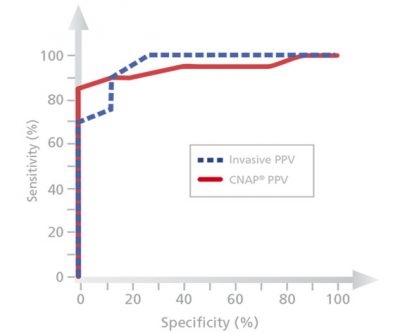NON-INVASIVE
PULSE PRESSURE VARIATION
Dynamic fluid parameters to improve the outcome in
moderate and low-risk
surgeries
CNAP® PPV | SVV
Pulse Pressure Variation (PPV) and Stroke Volume Variation (SVV) are dynamic fluid markers indicating the fluid responsiveness of a patient under general anesthesia for efficient fluid management over the course of Goal Directed Therapy (GDT).
CALCULATION FROM PULSE PRESSURE AND STROKE VOLUME
PPV as well as SVV are calculated from the minima and maxima of pulse pressure (PPV) or stroke volume (SVV) during a respiratory cycle.(1)
The CNAP® technology detects respiratory activity in the continuous CNAP® blood pressure signal automatically using a specifically designed algorithm. No connection to the airway pressure signal is required.

CNAP® PPV CLOSELY CORRELATES WITH INVASIVE PPV
The concept of hemodynamic optimization using non-invasive, continuous CNAP® PPV has rapidly found wide acceptance in anesthesia and critical care as the results perfectly agree with invasive standards.

CNAP® PPV has been validated against invasive clinical standards and shows high agreement.(2,3,4)
Non-invasive assessment of fluid responsiveness using CNAP® PPV seems to be interchangeable with invasive PPV in patients undergoing
major open abdominal surgery.(4)
This makes Goal Directed Therapy (GDT) available even for moderate- and low risk patients and surgeries.
IMPROVING OUTCOME
Goal-directed fluid therapy has the potential to improve outcomes after major surgery. Pulse pressure variation (PPV) is a dynamic variable that accurately predicts responsiveness to a fluid challenge.(4)

adapted from Benes et al.(5)
Personalized hemodynamic management using non-invasive pulse wave analysis with CNAP® reduces a composite outcome of major postoperative complications or death within 30 days after surgery compared with routine management in high-risk patients undergoing major abdominal surgery. (6)
ACCURATE & RELIABLE
Validation studies confirm that CNAP® PPV is highly accurate and comparable to invasive standards in various settings.


OUR PRODUCTS PROVIDING
CNAP® PPV | SVV
Get the full hemodynamic picture based on our CNAP® technology: non-invasive, continuous blood pressure, cardiac output, advanced hemodynamics and dynamic fluid parameters.
Non-invasive monitoring of blood pressure and advanced hemodynamics for medium and low-risk surgery.
Hemodynamic measurement just got easier – integration or interfacing
References:
(1) Michard et al. Clinical use of respiratory changes in arterial pulse pressure to monitor the hemodynamic effects of PEEP. Am J Respir Crit Care Med (1999) vol. 159 (3) pp. 935-9
(2) Biais, M. et al., The ability of pulse pressure variations obtained with CNAP™ device to predict fluid responsiveness in the operating room; Anesthesia and analgesia, 523-28 (2011).
(3) Monnet, X. et al., Prediction of fluid responsiveness by a continuous non-invasive assessment of arterial pressure in critically ill patients: comparison with four other dynamic indices. British Journal of Anaesthesia (2012).
(4) Renner J, et al. Non-invasive assessment of fluid responsiveness using CNAP™ technology is interchangeable with invasive arterial measurements during major open abdominal surgery. Br J Anaesth. 2017 Jan;118(1):58-67. doi: 10.1093/bja/aew399. PMID: 28039242.
(5) Benes, J et al. Fluid management guided by a CNAP device is associated with decreased postoperative morbidity after total knee and hip replacement. BMC Anesthesiology, 15(1), 148.(2015)
(6) Nicklas JY, et al. Personalised haemodynamic management targeting baseline cardiac index in high-risk patients undergoing major abdominal surgery: a randomised single-centre clinical trial. Br J Anaesth. 2020 Aug;125(2):122-132. doi: 10.1016/j.bja.2020.04.094. PMID: 32711724.

